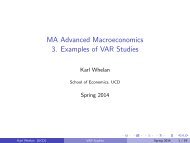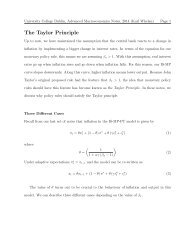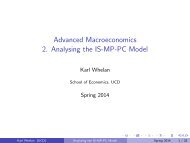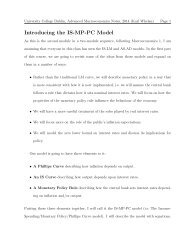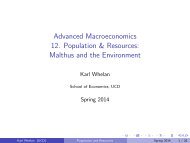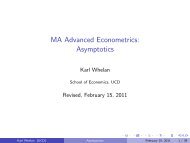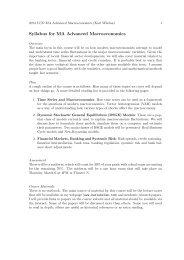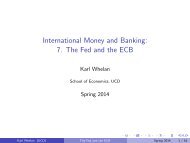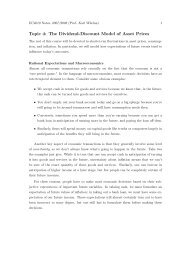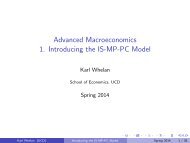Sample Questions for Macro 2 Midterm Exam - Karl Whelan
Sample Questions for Macro 2 Midterm Exam - Karl Whelan
Sample Questions for Macro 2 Midterm Exam - Karl Whelan
You also want an ePaper? Increase the reach of your titles
YUMPU automatically turns print PDFs into web optimized ePapers that Google loves.
1<strong>Sample</strong> <strong>Questions</strong> <strong>for</strong> Advanced <strong>Macro</strong>economics <strong>Midterm</strong> <strong>Exam</strong>The questions on the exam will be based on material up to and including past 6 of the notes.1. In his 1968 paper, Milton Friedman argued that(A) Workers bargained over expected nominal wages.(B) Workers bargained over expected real wages.(C) Governments could sustain low unemployment at the expense of low inflation.(D) Governments should use fiscal policy to mantain low inflation.2. Stagflation refers to(A) High inflation and high unemployment.(B) High inflation and low unemployment.(C) Deflation and low unemployment.(D) Deflation and high unemployment.3. The evidence on US inflation and unemployment data presented in the lecture notes(A) Shows a significant negative relationship between inflation and unemployment.(B) Shows a significant negative relationship between the change in inflation and unemployment.(C) Shows a significant positive relationship between the change in inflation and unemployment.(D) Shows a significant negative relationship between the inflation and the change unemployment.4. In the IS curve presented in the lecture notes, the “natural rate of interest” is(A) The nominal interest rate that stabilises output at its natural rate.(B) The nominal interest rate that stabilises inflation at the central bank’s target level.(C) The real interest rate that stabilises inflation at the central bank’s target level.(D) The real interest rate that stabilises output at its natural rate.
25. When monetary policy follows the rule i t = r ∗ + π ∗ + β π (π t − π ∗ ), the IS-MP curve:(A) Slopes down.(B) Slopes up.(C) Slopes down provided β π > 1.(D) Slopes down provided β π < 1.6. In the IS-MP-PC model, an upward shift in the Phillips curve leads to(A) Higher output and higher inflation.(B) Higher output and lower inflation.(C) Lower output and higher inflation.(D) Lower output and lower inflation.7. In the IS-MP-PC model, an upward shift in the IS-MP curve leads to(A) Higher output and higher inflation.(B) Higher output and lower inflation.(C) Lower output and higher inflation.(D) Lower output and lower inflation.8. In the IS-MP-PC model with β π > 1, what happens when the economy starts out with thepublic’s inflation expectations equalling the central bank’s inflation target and then theirinflation expectations rise above the central bank’s target rate?(A) Inflation increases, output falls and real interest rates rise.(B) Inflation increases, output increases and real interest rates rise.(C) Inflation increases, output falls and real interest rates fall.(D) Inflation increases, output increases and real interest rates fall.
39. In the IS-MP-PC model, inflation will tend to be closer to the central bank’s inflation targetand farther away from public’s expected value of inflation(A) When the response of output to interest rates is lower and the central bank’s rule has alarger response of interest rates to inflation.(B) When the response of output to interest rates is higher and the central bank’s rule hasa smaller response of interest rates to inflation.(C) When the response of output to interest rates is lower and the central bank’s rule has asmaller response of interest rates to inflation.(D) When the response of output to interest rates is higher and the central bank’s rule hasa larger response of interest rates to inflation.10. The Taylor principle refers to the idea that(A) Central banks should adjust interest rates by less than the change in inflation.(B) Central banks should adjust interest rates by more than the change in inflation.(C) Central banks should adjust interest rates in line with inflation and the output gap.(D) Central banks should adjust interest rates in line with inflation only.11. When monetary policy follows the rule i t = r ∗ + π ∗ + β π (π t − π ∗ ), which of the followingequations describes the inflation rate at which the central bank sets interest rates equal tozero?(A) π ZLB =(B) π ZLB =(C) π ZLB =(D) π ZLB =(βπβ π−1(βπβ π−1( ) βπ−1β π)π ∗ + r∗β π)π ∗ − r∗β ππ ∗ − r∗β π( ) βπ−1β ππ ∗ + r ∗12. Which of the following is true when short-term interest rates are at the zero bound?(A) Increased government spending reduces output and increased inflation expectations reducesoutput.(B) Increased government spending increases output and increased inflation expectationsreduces output.(C) Increased government spending increases output and increased inflation expectationsincreases output.(D) Increased government spending reduces output and increased inflation expectations increasesoutput.
413. When taking the zero lower bound <strong>for</strong> interest rates into account(A) The Phillips curve moves from being upward-sloped to being downward-sloped wheninterest rates hit zero.(B) The Phillips curve moves from being downward-sloped to being upward-sloped wheninterest rates hit zero.(C) The IS-MP curve moves from being upward-sloped to being downward-sloped wheninterest rates hit zero.(D) The IS-MP curve moves from being downward-sloped to being upward-sloped wheninterest rates hit zero.14. Consider the stochastic difference equation y t = ax t + bE t y t+1 . Applying the repeated substitutionmethod, an alternative expression <strong>for</strong> y t under rational expectations is(A)∞∑y t = a b k E t x t+kk=0(B)∞∑y t = b a k E t x t+kk=0(C)∞∏y t = a b k E t x t+kk=0(D)∞∏y t = b a k E t x t+kk=015. When the expected return on a stock is r and its dividends, D t , are expected to grow at rateg, the price of the stock under rational expectations is(A) P t = Dtr+g(B) P t =(C) P t = rDtr−g(D) P t = Dtr−gD t(1+r)(r+g)
516. Robert Shiller’s 1981 paper(A) Explained why stock prices are so volatile.(B) Argued that stock prices were too volatile to be consistent with rational expectations.(C) Argued that stock prices did not react enough to in<strong>for</strong>mation to be consistent withrational expectations.(D) Correctly predicted a stock market crash.17. Consider the following variable which moves around over time according to an AR(1) processy t = ρy t−1 + ɛ t where ɛ t is a random series of independent observations with a zero averages.Which of the following is the right expression <strong>for</strong> E t y t+k ?(A) y t + ρk(B) ρ k y t(C) (ρ + k) y t(D) ρ −k y t18. Which of the following describes the assumptions required to derive the random walk theoryof consumption?(A) A quadratic utility function and a rate of time discount that was greater than the returnon assets.(B) A quadratic utility function and a rate of time discount that was less than the returnon assets.(C) A quadratic utility function and a rate of time discount that equalled the return onassets.(D) A constant relative risk aversion utility function.19. The Consumption CAPM model can be used to model the equity premium (the differencebetween the average return on stocks and the return on safe assets). The model has difficultyexplaining(A) Why the equity premium is so high and why the risk-free rate is so high.(B) Why the equity premium is so low and why the risk-free rate is so high.(C) Why the equity premium is so high and why the risk-free rate is so low.(D) Why the equity premium is so low and why the risk-free rate is so low.
6Correct Answers1. B2. A3. B4. D5. C6. C7. A8. A9. D10. B11. C12. C13. D14. A15. D16. B17. B18. C19. C



